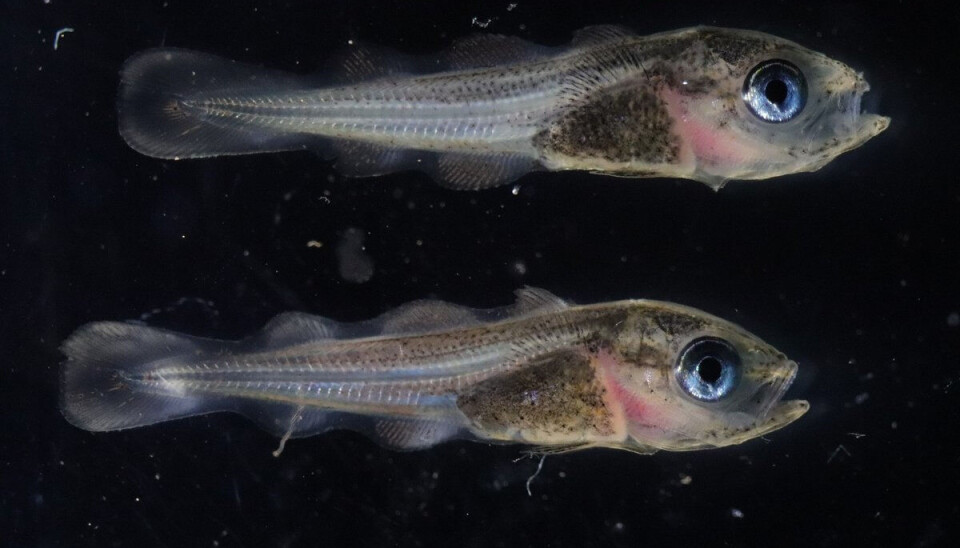THIS ARTICLE/PRESS RELEASE IS PAID FOR AND PRESENTED BY the Institute of Marine Research - read more

Magnetic fields from subsea cables can slow down haddock larvae
Haddock larvae swam more slowly after being exposed to magnetic fields similar to those created by undersea cables connecting offshore wind farms in the laboratory.
Offshore wind farms and other marine renewable energy facilities are connected by submarine high-voltage cables. These cables produce magnetic fields that can affect marine organisms that swim or drift near the cables – particularly fish larvae that have less ability to swim away from the cables.
These possible impacts could be particularly relevant for fish larvae, which have limited capacity to swim away from the cables. However, whether there is an effect on fish larvae is currently unknown. Ongoing research at the Institute of Marine Research (IMR) is beginning to fill this knowledge gap.
In their most recent study, a research team at IMR focused on impacts on haddock – an ecologically and commercially important species that is also a popular choice for fish and chips.
Reduced swimming activity

“We wanted to understand whether haddock larvae, which will drift in areas where offshore wind turbines are planned, are affected by magnetic fields in the intensity range of those generated by the subsea cables that connect the turbines,” says Alessandro Cresci, a postdoctoral fellow at IMR.
The researchers set up an experiment that simulated a scenario where fish larvae swam or drifted past an undersea cable. The behaviour of the larvae was filmed and analysed.
“We found no evidence of attraction to or repulsion from the magnetic field. However, the exposure reduced by more than half the swimming activity of the great majority of the haddock larvae, and substantially reduced their acceleration,” Cresci says. “This reduction in swimming activity could affect the dispersal and survival of haddock larvae in the wild.”
Swims according to its own compass
In earlier research, Cresci and colleagues found that haddock larvae don’t just drift passively with the current; rather, they swim in a north-westerly direction, following an internal magnetic 'compass'.
This directional swimming plays a role in determining where the newly hatched larvae end up after spawning. Therefore, if their swimming activity is reduced as the larvae drift past subsea cables, this could impact their dispersal and lower their chances to survive.
“For this reason, we wanted to understand whether haddock larvae, which will drift in areas where offshore wind turbines are planned, are affected by magnetic fields in the intensity range of those generated by the subsea cables connecting the turbines,” Cresci says.
Realistic simulation in a test tank
The experiment was carried out in a special tank built for the purpose, with electric coils that could induce magnetic fields in one half of the tank. The intensity of the magnetic field was the same as from ordinary subsea cables.
The set-up thus gave a realistic imitation of what larvae will experience when they swim or drift near an undersea high-voltage cable in the wild.
“We placed the larvae one at a time in the middle of the raceway and observed their behaviour for 15 minutes. Half of the larvae could freely swim between the high and low magnetic field zones,” Cresci explains.
Half of the larvae were exposed to the magnetic field; the rest were observed under similar conditions, but with the electric coils switched off, so that they were only exposed to the natural magnetic field of the earth. These served as controls in the experiment.
The experiment was conducted in the dark, with no visual cues that could influence the behavior of the larvae. The behaviour of the larvae was recorded using an infrared-sensitive camera.

Clear differences
The haddock larvae showed clear differences in exploratory behavior: A minority (20 per cent) of the larvae were highly exploratory and swam back and forth in the raceway tank. Most (80 per cent) of the larvae were non-exploratory and kept to one side of the raceway tank. This pattern of individual differences in behavior has been observed in several species of fish.
The effect was different between the two groups:
The exposure to magnetic fields in the range of those produced by high voltage subsea cables reduced the swimming speed of non-exploratory larvae by more than half (60 per cent) compared to the controls. Their acceleration was also strongly reduced (by 38 per cent).
There was no such effect on the exploratory group of fish.
Unique and important findings
This experiment on haddock larvae is part of a larger research project on the impacts of offshore wind farms on fish larvae. The project is assessing the impacts of operational noise from wind farm turbines and magnetic fields from subsea cables on fish larvae.
In a similar study published earlier this year, the IMR team found no significant effect of magnetic fields on larvae of lesser sandeel (Ammodytes marinus), a key species in the North Sea ecosystem. The researchers plan to do an analogous experiment on Atlantic cod larvae.
In addition, they have carried out unique research on the impacts of low-frequency sound in the intensity range of those produced by the turbines on marine fish larvae.
“The expansion of the offshore wind industry is underway, and it’s happening fast. We have made significant advances in the understanding of the possible impacts this might have on early-life stages of fish,” Cresci says.
“Our results provide some of the first evidence of the possible ecological future impacts of this expansion. This type of research should be taken into consideration when evaluating the possible implications of this further industrialisation of the sea for marine life.”
Reference:
Cresci et al. 'Magnetic fields produced by subsea high voltage DC cables reduce swimming activity of haddock larvae (Melanogrammus aeglefinus)', PNAS Nexus, 2022. DOI: 10.1093/pnasnexus/pgac175 Abstract.

This article/press release is paid for and presented by the Institute of Marine Research
This content is created by the Institute of Marine Research's communication staff, who use this platform to communicate science and share results from research with the public. The Institute of Marine Research is one of more than 80 owners of ScienceNorway.no. Read more here.
See more content from the Institute of Marine Research:
-
These whales have summer jobs as ocean fertilisers
-
Have researchers found the world’s first bamboo coral reef?
-
Herring suffered collective memory loss and forgot about their spawning ground
-
Researchers found 1,580 different bacteria in Bergen's sewage. They are all resistant to antibiotics
-
For the first time, marine researchers have remotely controlled an unmanned vessel from the control room in Bergen
-
New discovery: Cod can adjust to climate change – from one generation to the next




































